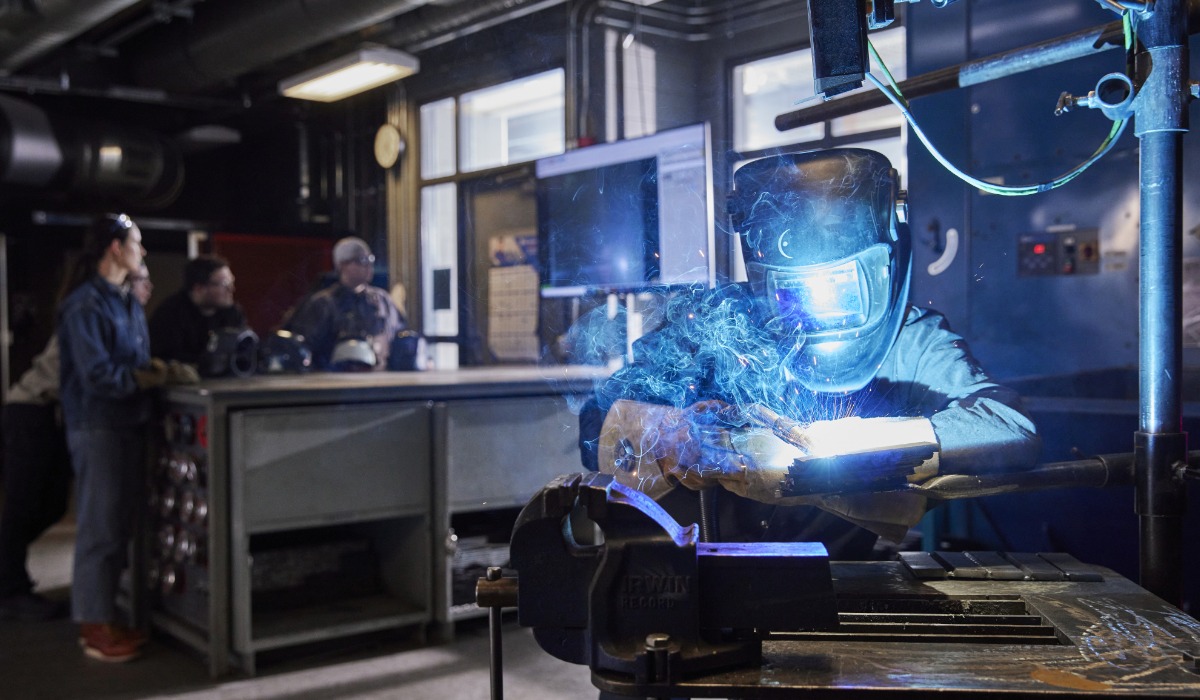Overview
Learn how to join or sever metals in beams, girders, vessels, piping and other metal components. You'll make metal parts used in construction and manufacturing plants, and weld parts, tools, machines and equipment.
There are two different specializations for this trade.
Welder
On the job, you’ll apply heat to metal pieces to melt and fuse them. Different welding methods and fillers are used depending on the type of metal, its size and shape and how strong the final piece needs to be. The different types of welding include:
- Electric Arc Welding: an electric current creates heat by jumping between the tip of a welding electrode and the metal to melt it.
- Gas Welding: a flame made by burning gases melts the metal.
- Resistance Welding: electricity passes through the metal, heating it up until it melts, without needing extra filler material.
For a typical welding project, you'll:
- develop patterns for projects or follow directions given in layouts, blueprints and work orders
- clean, check for defects and shape parts, sometimes using a cutting torch
- weld parts together.
You may also build up worn parts by welding layers of high-strength hard-metal alloys onto them.
Welder-Wire Process Operator
You’ll work primarily in production and manufacturing plants, joining components and sub-assemblies to make various items using various construction materials.
Welding in this branch of the welder trade is restricted to:
- gas metal arc welding (GMAW)
- flux cored arc welding (FCAW)
- submerged arc welding (SAW)
- other semiautomatic wire feed welding processes.
The welder-wire process operator uses different welding processes and filler metals depending upon the type of metal, its size and shape, and requirements for finished mechanical properties. This one-year specialty shares a common first year with the Welder apprenticeship.
To work in this trade, certification is required. This means that you must either be a registered apprentice working under the guidance of a certified journeyperson or be a certified journeyperson yourself.
To succeed in these trades, you should:
- have good hand-eye coordination and vision
- have the strength and stamina to carry heavy tools
- be able to visualize a finished product from a document
- be able to to concentrate on detailed work
- be patient and dependable
- be comfortable working in a construction or shop environment
- be committed to maintaining safe working conditions.
Upon successfully completing the required working hours and technical training periods, you'll be awarded a diploma (Welder) or a certificate (Wire Process Operator) and journeyperson status by Alberta’s Apprenticeship and Industry Training.
This is a Red Seal Endorsed trade – a recognizable standard that allows tradespeople to work across Canada.
Careers and opportunities
Our graduates may work in the following occupations. Some careers require additional experience and education.
Associated National Occupational Classification (NOC) codes: 22302, 72010, 72104, 72106, 92023, 94105, 95101.
Apprenticeship training
Depending on the specialization, you'll require one or three periods of apprenticeship education and on-the-job training before becoming a journeyperson.
The term of apprenticeship for a welder is three years (three 12-month periods), including a minimum of 1560 hours of on-the-job training and eight weeks of classroom instruction each year.
Year 1 | Period 1
You'll learn about workplace safety and tools. You’ll also cover welding technology and properties of metals, gas metal arc welding (GMAW), flux cored arc welding (FCAW), metal cored arc welding (MCAW), submerged arc welding (SAW) and trade math.
Training length: 8 weeks
Year 2 | Period 2
You'll learn about shielded metal arc welding (SMAW) level one, gas tungsten arc welding (GTAW) level one, pattern development, estimating and SMAW level two.
Training length: 8 weeks
Year 3 | Period 3
You'll learn about shielded metal arc welding (SMAW) level three, welding on mild steel plate and pipe, drawing interpretation and trade science.
Training length: 8 weeks
The term of apprenticeship for a Welder-Wire Process Operator is two years (two 12-month periods) including:
- a minimum of 1500 hours of on-the-job training and eight weeks of classroom instruction in the first year
- 1800 hours of on-the-job training in the second year.
Year 1 | Period 1
You'll learn about workplace safety and tools. You'll also cover welding technology and properties of metals, gas metal arc welding (GMAW), flux cored arc welding (FCAW), metal cored arc welding (MCAW), submerged arc welding (SAW) and trade math.
Training length: 8 weeks
Year 2 | Period 2
You'll complete 1,800 hours of on-the-job training. No schooling is required.
Apprenticeship education performance
You must pass each section of the course and the AIT exam to succeed in apprenticeship education.
The passing grade for each period is no less than 50% in each course, with no less than a 65% average overall. A passing mark on each provincial exam and the interprovincial qualification (Red Seal Exam) is 70%.
View Alberta's Apprenticeship and Industry Training procedures
Training pathways
You can earn your journeyperson designation in the following way.
The traditional training pathway begins with finding a job with an employer willing to indenture you as an apprentice. Once you are an apprentice, you'll alternate between on-the-job training and educational periods.
You must apply for an apprenticeship through Alberta Apprenticeship and Industry Training before attending your first education period at SAIT.
Pre-employment pathway
SAIT’s Pre-employment Welding program prepares you to enter into an apprenticeship with hands-on skills. Upon successfully completing the program, you’ll qualify to challenge the first-year Welder apprenticeship exam.
Admission requirements
To enter an apprenticeship, you must have the educational qualifications required or recommended education for the trade to which you apply.
Entrance requirements are monitored and set by Alberta Apprenticeship and Industry Training.
Minimum requirements
Successful completion of the following courses:
- English 10-2
- Math 10-3
OR
A pass mark in all five Canadian General Educational Development (GED) tests
OR
Alberta Apprenticeship and Industry Training Entrance Exam
Recommended requirements
Apprentices with an Alberta High School Diploma that includes the following courses:
- English 30-2
- Math 30-3
- Physics 20 OR Chemistry 20 OR Science 20
- Related career and technology studies (CTS) courses
MyTradeSecrets
Once you have begun working as an apprentice, you can attend SAIT to complete your technical training.
You'll register for technical training at SAIT on MyTradeSecrets or you can register by phone.
Transfer agreements
At SAIT, we have created transfer agreements with partner institutions to allow you to earn course credits toward your SAIT program based on your previously completed credentials.
Transfer Alberta search tool
Use the Transfer Alberta search tool to see all transfer agreements between Alberta post-secondary institutions (including those with the University of Calgary, Mount Royal University and Bow Valley College.)
Search transfer agreements in Alberta
Transfer options for graduates
When you have completed this program, you may continue your education at a partner post-secondary institution. These transfer agreements include partnerships within and/or outside of Canada.
Credits this program transfers to
- Available credits:
- 42
- Available credits:
- 45
Available intakes
Costs
2025/26 tuition and fees
The following costs are effective as of July 1, 2025.
Welder
Welder - Wire Process Operator
| Period | Number of weeks | Tuition fees | Additional fees |
Total |
|---|---|---|---|---|
| 1 | 8 | $1,200 | $339.16 | $1,539.16 |
|
Total cost:
|
$1,539.16 | |||
This is a bring-your-own-device program with standard computer hardware and software requirements. See the specific requirements on our computers and laptops page.
Books or modules, along with other items for classes, are approximately $670 per period.
We recommend you don't purchase books or modules ahead of time as they might be outdated by the time you attend classes, and they cannot be returned to the Bookstore.
Personal protective equipment (PPE) will be required for the program, which may be an additional cost to apprentices.
Funding options for apprentices
Apprentices get to learn while they earn, but there are still costs to consider. Many resources are available at SAIT and federally to help support apprentices.
Information sessions
Prepare for a strong start in your chosen program or get the details you need to decide your future path.
Our expert staff and faculty are ready to answer your questions and provide information about the following:
- What sets SAIT apart
- An introduction to the program and area of study
- Admission requirements
- Future career paths
- Information on the earning potential and graduate employment rates.
Contact
Have more questions?
Technical training at SAIT
School of Manufacturing and Automation
-
Phone - 403.284.8641
-
Email - ma.info@sait.ca
Apprenticeship training and registration
Apprenticeship and Industry Training Client Services

Oki, Âba wathtech, Danit'ada, Tawnshi, Hello.
SAIT is located on the traditional territories of the Niitsitapi (Blackfoot) and the people of Treaty 7 which includes the Siksika, the Piikani, the Kainai, the Tsuut’ina and the Îyârhe Nakoda of Bearspaw, Chiniki and Goodstoney.
We are situated in an area the Blackfoot tribes traditionally called Moh’kinsstis, where the Bow River meets the Elbow River. We now call it the city of Calgary, which is also home to the Métis Nation of Alberta.
